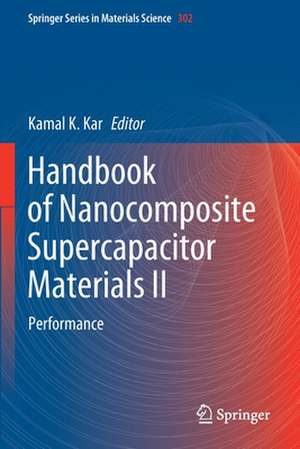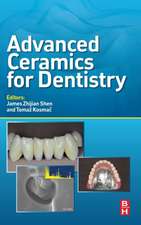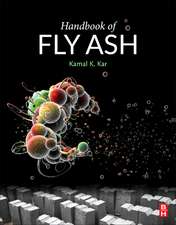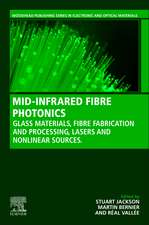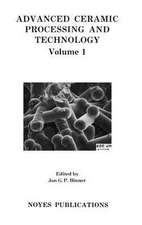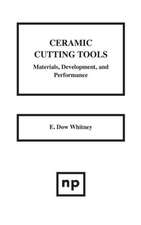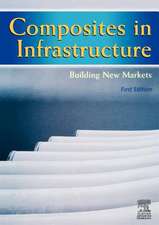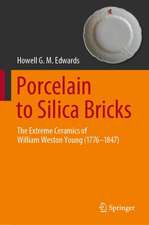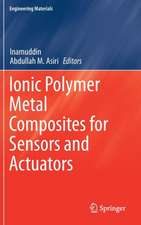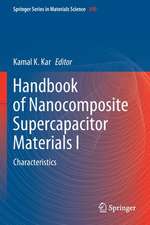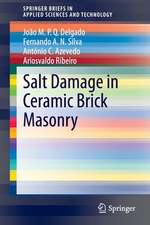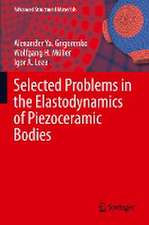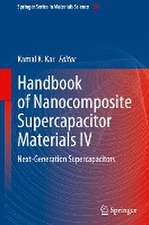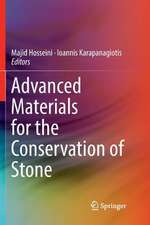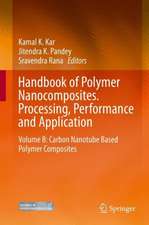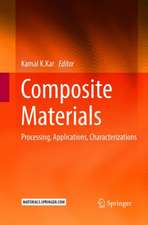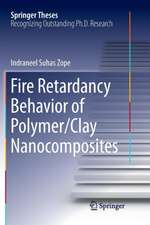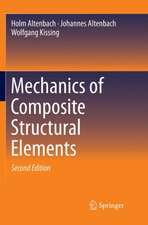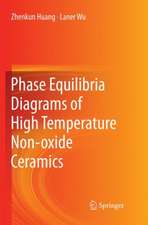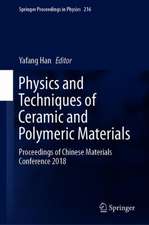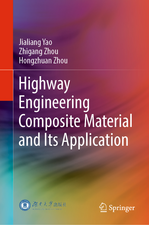Handbook of Nanocomposite Supercapacitor Materials II: Performance: Springer Series in Materials Science, cartea 302
Editat de Kamal K. Karen Limba Engleză Paperback – 2 aug 2021
This book is part of the Handbook of Nanocomposite Supercapacitor Materials. Supercapacitors have emerged as promising devices for electrochemical energy storage, playing an important role in energy harvesting for meeting the current demands of increasing global energy consumption. The handbook covers the materials science and engineering of nanocomposite supercapacitors, ranging from their general characteristics and performance to materials selection, design and construction. Covering both fundamentals and recent developments, this handbook serves a readership encompassing students,professionals and researchers throughout academia and industry, particularly in the fields of materials chemistry, electrochemistry, and energy storage and conversion. It is ideal as a reference work and primary resource for any introductory senior-level undergraduate or beginning graduate course covering supercapacitors.
| Toate formatele și edițiile | Preț | Express |
|---|---|---|
| Paperback (1) | 1118.45 lei 6-8 săpt. | |
| Springer International Publishing – 2 aug 2021 | 1118.45 lei 6-8 săpt. | |
| Hardback (1) | 1124.78 lei 6-8 săpt. | |
| Springer International Publishing – aug 2020 | 1124.78 lei 6-8 săpt. |
Din seria Springer Series in Materials Science
- 18%
 Preț: 1820.22 lei
Preț: 1820.22 lei - 18%
 Preț: 776.09 lei
Preț: 776.09 lei - 24%
 Preț: 689.69 lei
Preț: 689.69 lei - 18%
 Preț: 968.96 lei
Preț: 968.96 lei - 20%
 Preț: 568.95 lei
Preț: 568.95 lei - 18%
 Preț: 953.65 lei
Preț: 953.65 lei - 18%
 Preț: 902.36 lei
Preț: 902.36 lei - 18%
 Preț: 953.65 lei
Preț: 953.65 lei - 20%
 Preț: 948.42 lei
Preț: 948.42 lei - 18%
 Preț: 1143.07 lei
Preț: 1143.07 lei - 18%
 Preț: 1111.53 lei
Preț: 1111.53 lei - 18%
 Preț: 1103.62 lei
Preț: 1103.62 lei - 18%
 Preț: 1225.94 lei
Preț: 1225.94 lei -
 Preț: 473.91 lei
Preț: 473.91 lei - 18%
 Preț: 782.42 lei
Preț: 782.42 lei -
 Preț: 433.47 lei
Preț: 433.47 lei - 18%
 Preț: 1116.40 lei
Preț: 1116.40 lei - 18%
 Preț: 946.24 lei
Preț: 946.24 lei - 18%
 Preț: 945.20 lei
Preț: 945.20 lei - 18%
 Preț: 1114.21 lei
Preț: 1114.21 lei - 15%
 Preț: 641.20 lei
Preț: 641.20 lei - 18%
 Preț: 958.56 lei
Preț: 958.56 lei - 18%
 Preț: 1224.36 lei
Preț: 1224.36 lei - 15%
 Preț: 644.82 lei
Preț: 644.82 lei - 24%
 Preț: 833.45 lei
Preț: 833.45 lei - 24%
 Preț: 1060.36 lei
Preț: 1060.36 lei - 18%
 Preț: 964.10 lei
Preț: 964.10 lei - 18%
 Preț: 1224.36 lei
Preț: 1224.36 lei - 18%
 Preț: 1221.20 lei
Preț: 1221.20 lei - 18%
 Preț: 946.87 lei
Preț: 946.87 lei - 18%
 Preț: 1836.92 lei
Preț: 1836.92 lei - 15%
 Preț: 643.34 lei
Preț: 643.34 lei - 18%
 Preț: 1246.32 lei
Preț: 1246.32 lei - 18%
 Preț: 956.81 lei
Preț: 956.81 lei - 18%
 Preț: 953.52 lei
Preț: 953.52 lei - 15%
 Preț: 637.59 lei
Preț: 637.59 lei
Preț: 1118.45 lei
Preț vechi: 1363.96 lei
-18% Nou
Puncte Express: 1678
Preț estimativ în valută:
214.08€ • 232.62$ • 179.95£
214.08€ • 232.62$ • 179.95£
Carte tipărită la comandă
Livrare economică 21 aprilie-05 mai
Preluare comenzi: 021 569.72.76
Specificații
ISBN-13: 9783030523619
ISBN-10: 3030523616
Ilustrații: XXIII, 496 p. 262 illus., 180 illus. in color.
Dimensiuni: 155 x 235 mm
Greutate: 0.72 kg
Ediția:1st ed. 2020
Editura: Springer International Publishing
Colecția Springer
Seria Springer Series in Materials Science
Locul publicării:Cham, Switzerland
ISBN-10: 3030523616
Ilustrații: XXIII, 496 p. 262 illus., 180 illus. in color.
Dimensiuni: 155 x 235 mm
Greutate: 0.72 kg
Ediția:1st ed. 2020
Editura: Springer International Publishing
Colecția Springer
Seria Springer Series in Materials Science
Locul publicării:Cham, Switzerland
Cuprins
Transition Metal Oxide as Electrode Material for Supercapacitors.- Activated Carbon as Electrode Material for Supercapacitors.- TMO/Activated Carbon Based Composite as Electrode Material for Supercapacitors.- Carbon Nanofiber as Electrode Material for Supercapacitors.- TMO/Carbon Nanofiber based Composite as Electrode Material for Supercapacitors.- Carbon Nanotube as Electrode Material for Supercapacitors.- Transition Metal Oxide/Carbon Nanotube Based Composite as Electrode Material for Supercapacitors.- Graphene/Reduced Graphene as Electrode Material for Supercapacitors.- TMO/Graphene/Reduced Graphene Oxide Based Composite as Electrode Material for Supercapacitors.- Polymer as Electrode Material for Supercapacitors.- TMO/Electronically Conducting Polymer Based Composite as Electrode Material for Supercapacitors.- Transition Metal Oxides Based Ternary Composite as Electrode Material for Supercapacitors.- Applications and Future Trends of Supercapacitors.
Textul de pe ultima copertă
This book covers the performance aspects of nanocomposite supercapacitor materials based on transition metal oxides, activated carbon, carbon nanotubes, carbon nanofibers, graphene and conducting polymers. It compares the performance of simple electrode materials versus binary and ternary composites, while highlighting the advantages and challenges of different supercapacitor electrode materials.
This book is part of the Handbook of Nanocomposite Supercapacitor Materials. Supercapacitors have emerged as promising devices for electrochemical energy storage, playing an important role in energy harvesting for meeting the current demands of increasing global energy consumption. The handbook covers the materials science and engineering of nanocomposite supercapacitors, ranging from their general characteristics and performance to materials selection, design and construction. Covering both fundamentals and recent developments, this handbook serves a readership encompassing students,professionals and researchers throughout academia and industry, particularly in the fields of materials chemistry, electrochemistry, and energy storage and conversion. It is ideal as a reference work and primary resource for any introductory senior-level undergraduate or beginning graduate course covering supercapacitors.
This book is part of the Handbook of Nanocomposite Supercapacitor Materials. Supercapacitors have emerged as promising devices for electrochemical energy storage, playing an important role in energy harvesting for meeting the current demands of increasing global energy consumption. The handbook covers the materials science and engineering of nanocomposite supercapacitors, ranging from their general characteristics and performance to materials selection, design and construction. Covering both fundamentals and recent developments, this handbook serves a readership encompassing students,professionals and researchers throughout academia and industry, particularly in the fields of materials chemistry, electrochemistry, and energy storage and conversion. It is ideal as a reference work and primary resource for any introductory senior-level undergraduate or beginning graduate course covering supercapacitors.
Caracteristici
Covers the performance aspects of several types of supercapacitor materials Compares simple electrode materials with binary and ternary composites Highlights advantages and challenges of different supercapacitor electrode materials
